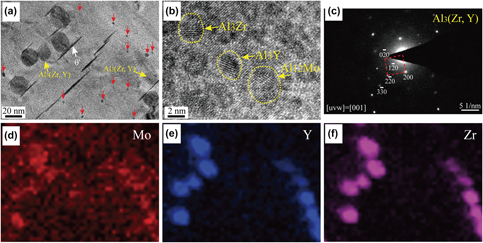Crossref Citations
This article has been cited by the following publications. This list is generated based on data provided by
Crossref.
Poplawsky, Jonathan D.
Milligan, Brian K.
Allard, Lawrence F.
Shin, Dongwon
Shower, Patrick
Chisholm, Matthew F.
and
Shyam, Amit
2020.
The synergistic role of Mn and Zr/Ti in producing θ′/L12 co-precipitates in Al-Cu alloys.
Acta Materialia,
Vol. 194,
Issue. ,
p.
577.
Seikh, Ziyauddin
Huraira Biswas, Abu
Kamaruzzaman, Md
Haque, Rafiqul
Kibria, Golam
Haidar, Shamim
and
Sekh, Mukandar
2021.
Density, hardness and wear responses of aluminium-copper-magnesium alloys.
Materials Today: Proceedings,
Vol. 47,
Issue. ,
p.
2358.
Pan, Yong
and
Yu, Ende
2021.
First-principles investigation of structural stability, mechanical and thermodynamic properties of Pt3Zr5 compounds.
Physica B: Condensed Matter,
Vol. 611,
Issue. ,
p.
412936.
Bansal, Ujjval
and
Chattopadhyay, Kamanio
2022.
Newer Developments in Aluminium Alloys Through Ordered Precipitates and Segregation of Transition Elements.
Transactions of the Indian Institute of Metals,
Vol. 75,
Issue. 4,
p.
1015.
Poplawsky, Jonathan D.
Michi, Richard A.
Allard, Lawrence F.
Bahl, Sumit
Plotkowski, Alex J.
and
Shyam, Amit
2022.
Using θ′ interfaces as templates for planar L12 precipitation in AlCuMnZr alloys.
Additive Manufacturing Letters,
Vol. 3,
Issue. ,
p.
100086.
Poplawsky, Jonathan D.
Michi, Richard
Allard, Lawrence
Bahl, Sumit
Plotkowski, Alex
and
Shyam, Amit
2022.
Using Θ' Interfaces as Templates for Planar L12 Precipitation in Alcumnzr Alloys.
SSRN Electronic Journal ,
Dai, Jun-Nan
Kou, Shu-Qing
Yang, Hong-Yu
Xu, Zheng-Bo
Shu, Shi-Li
Qiu, Feng
Jiang, Qi-Chuan
and
Zhang, Lai-Chang
2022.
High-content continuous carbon fibers reinforced PEEK matrix composite with ultra-high mechanical and wear performance at elevated temperature.
Composite Structures,
Vol. 295,
Issue. ,
p.
115837.
Tao, Chengchuang
Huang, Hongjun
Yuan, Xiaoguang
Yue, Chunyu
Su, Ming
and
Zuo, Xiaojiao
2022.
Effect of Y Element on Microstructure and Hot Tearing Sensitivity of As-Cast Al–4.4Cu–1.5Mg–0.15Zr Alloy.
International Journal of Metalcasting,
Vol. 16,
Issue. 2,
p.
1010.
Mondol, Sukla
Bansal, Ujjval
Singh, Mahander Pratap
Dixit, Saurabh
Mandal, Animesh
Paul, Aloke
and
Chattopadhyay, Kamanio
2022.
Microstructure-strength correlations in Al-Si-Cu alloys micro-alloyed with Zr.
Materialia,
Vol. 23,
Issue. ,
p.
101449.
Mondol, Sukla
Bansal, Ujjval
Singh, Mahander Pratap
Dixit, Saurabh
Mandal, Animesh
Paul, Aloke
and
Chattopadhyay, Kamanio
2022.
Microstructure-Strength Correlations in Al-Si-Cu Alloys Micro-Alloyed with Zr.
SSRN Electronic Journal ,
Yang, Yuping
Su, Ruiming
Ma, Siyi
Li, Guanglong
Qu, Yingdong
and
Li, Rongde
2022.
Effect of Zr Content on the Microstructure and Corrosion Resistance of Al–Cu–Mn Alloy.
Russian Journal of Non-Ferrous Metals,
Vol. 63,
Issue. 6,
p.
681.
Dai, Hongbin
Wang, Lang
Dong, Bolun
Miao, Jian
Lin, Sanbao
and
Chen, Hongtao
2023.
Microstructure and high-temperature mechanical properties of new-type heat-resisting aluminum alloy Al6.5Cu2Ni0.5Zr0.3Ti0.25V under the T7 condition.
Materials Letters,
Vol. 332,
Issue. ,
p.
133503.
Cai, Zhiyong
Liu, Haijiang
Wang, Richu
Peng, Chaoqun
Feng, Yan
and
Wang, Xiaofeng
2023.
Microstructure and Mechanical Properties of the Extruded Al-Cu-Mn-Sc-Zr Alloy during Single-Stage and Two-Stage Aging.
Journal of Materials Engineering and Performance,
Vol. 32,
Issue. 1,
p.
185.
Zhang, Han
Hao, Qitang
Li, Xinlei
Yu, Wentao
and
Xue, Yanqing
2023.
Coupled Precipitation of Dual-Nanoprecipitates to Optimize Microstructural and Mechanical Properties of Cast Al–Cu–Mg–Mn Alloys via Modulating the Mn Contents.
Nanomaterials,
Vol. 13,
Issue. 23,
p.
3038.
Liu, Kun
Wang, Shuai
Hu, Peng
Pan, Lei
and
Chen, X.-Grant
2023.
Improved Thermo-Mechanical Fatigue Resistance of Al-Si-Cu 319 Alloys by Microalloying with Mo.
Materials,
Vol. 16,
Issue. 9,
p.
3515.
Tang, Pang
Yu, Kailai
Qin, Luman
and
Huang, Saisha
2023.
Effect Mechanism of Sc Addition and T6 Heat Treatment on Precipitated Phase and Mechanical Properties of Al‐Cu‐Mn Alloy.
physica status solidi (a),
Vol. 220,
Issue. 15,
Hu, Te
Ruan, Zixiong
Fan, Touwen
Chen, Dongchu
Wu, Yuanzhi
and
Tang, Pingying
2023.
First-principles calculations to investigate stability, mechanical and thermo-dynamic properties of AlxTMy intermetallics in aluminum alloys.
Solid State Communications,
Vol. 376,
Issue. ,
p.
115361.
Hu, Kuishen
Zou, Chunming
Wang, Hongwei
and
Wei, Zunjie
2023.
Influence of Ti elements on the evolution of microstructure, mechanical properties and thermal stability of Al-Cu alloy.
Journal of Alloys and Compounds,
Vol. 952,
Issue. ,
p.
169860.
Liu, Jingbin
Hu, Jingyi
Li, Mengyu
Liu, Guiliang
Wu, Yuying
Gao, Tong
Liu, Shushuai
and
Liu, Xiangfa
2024.
Influence of Zr Microalloying on the Microstructure and Room-/High-Temperature Mechanical Properties of an Al–Cu–Mn–Fe Alloy.
Materials,
Vol. 17,
Issue. 9,
p.
2022.
Cui, Junge
Zeng, Guangkai
Gupta, Nikhil
Luo, Yue
Fu, Xiangzhou
Yang, Hailong
Li, Anmin
and
Pan, Liwen
2024.
Microstructure and Tensile Property of Al3Zr/Al-Cu-Ni-V Composite Prepared by In Situ Reaction.
Journal of Materials Engineering and Performance,
Vol. 33,
Issue. 12,
p.
6146.
